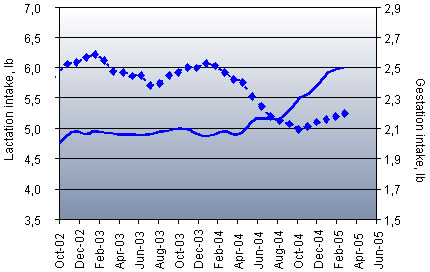The challenge of feeding the lactating sow is not new and improvement to the genetic potential of lean and prolific dam lines make this issue of critical importance for any breeding herd.
Context and challenges of modern sows during lactation

One of the challenges of feeding the modern sow is how to support increased milk production associated with increased litter size. Today sows have to support litter growth rates of 2 to 3 kg/day or more (Etienne et al., 2000). This corresponds to milk production of 8-12 litres/day or more (Noblet et al, 1998). Secondly, the weight of sows at maturity (260-290 kg) has increased with concomitant increases in maintenance requirements (Noblet et al., 1998; Dourmad et al., 2001). Genetic improvement for both weight gain and lean has resulted in either a reduction in the sow appetite (Aherne, 2001) or intakes have not increased in the same proportion as their energy requirements (Noblet et al., 1998). The end result of the above is best summarized in Table 1. As the ME content of the diet referred to in this table is typical of current practices (13.6 MJ ME/kg or 3250 kcal ME/kg), the amount of feed actually required could represent a real challenge in many farm situations. In reality, appetite is often not sufficient and sows have to draw form their body reserves.
Table 1. Energy and feed requirements of lactating sows according to bodyweight and litter weight gain (Noblet, Étienne and Dourmad, 1998)
| Litter weight gain (kg/day) | 2.0 | 3.0 | ||
| Sow bodyweight (kg) | 200 | 300 | 200 | 300 |
| Maintenance requirement (MJ ME/day) | 24.5 | 28.9 | 24.5 | 28.9 |
| Milk production requirement (MJ ME/day) | 52.0 | 52.0 | 79.6 | 79.6 |
| Total energy requirement (MJ ME/day) | 76.5 | 80.9 | 104.1 | 108.5 |
| eed required for the entire lactation (kg/day) | 5.63 | 5.95 | 7.65 | 7.98 |
Using body reserves could lead to excessive weight loss and reduced litter weight gain (lowered milk production) and subsequent reproductive problems for sows (Aherne, 2001). These conclusions are widely accepted with the body of evidence showing why lactation is a crucial cornerstone of sow production and reproductive efficiency. Therefore, for the modern lean and prolific sow everything must be done to maximize lactation feed intake (Goodband et al, 2006).
Factors influencing lactation feed intake
1. Feeding during previous gestation: Any overfeeding during gestation will systematically compromise the feed intake of sows or gilts in the following lactation (Quiniou et al, 1998; Whittemore, 1998; Noblet et al., 1998). In addition the long term consequence of this overfeeding will lead to overweight and premature culling due to productivity or various locomotor problems. Very often, the problem with dry sow feeding is the feed allowance is set according to subjective assessment of the need of each sow or group of sows, often leading to incorrect assumptions concerning the sows condition and therefore systematic over-feeding (Goodband et al., 2006). Dry sows should be fed as precisely as possible using more objective techniques to assess individual body weight, body condition (score determined following visual appraisal and palpation at hip bone level), and ideally, measurement of back-fat depth (Dourmad et al., 2001; Goodband et al., 2006). Research conducted at Kansas State University (Table 2) demonstrated that fatter sows at farrowing have lower feed intakes during lactation, lose more of their reserve and are less prolific at the next parity (Young et al., 2004). Most authors agree that feed intake problems during lactation will most likely occur in sows with back-fat depths of 23mm or more at farrowing (Aherne, 2001; Dourmad et al, 2001, Goodband et al., 2006).
Table 2. Effect of backfat at farrowing on feed intake, performance of sows in lactation and subsequent performances (Young et al., 2004)
| P2 Backfat at farrowing, mm | P< | |||
| < 17 | 17 to 21 | > 21 | ||
| No. of sows | 123 | 258 | 162 | |
| Lactation daily feed intake, kg | 6.06 | 5.93 | 5.73 | 0.04 |
| Estimated maternal weight loss, kg | 1.9 | 5.6 | 6.3 | 0.08 |
| Sow Backfat loss, mm | 2.1 | 3.2 | 4.8 | 0.01 |
| Subsequent performance: Nb of sows | 93 | 200 | 131 | |
| Subsequent performance: Total Born | 11.8 | 12.1 | 11.1 | 0.02 |
The precision of the actual amount of dry sow feed delivered manually or by automatic feeding systems needs to be checked on a regular basis because feed density and therefore volumetric measurements will vary with each load of feed delivered (Goodband et al., 2006). Gestation feeding programs need to be validated by your nutritionist in order to more precisely adjust feed allowance settings to the specific diet density used on your farm and feeding targets (bodyweight and back-fat gains which could be genotype specific). Figure 1 illustrates the lactation intake results from a large US production system that lowered their gestation intakes after initially overfeeding during gestation.
Figure 1. Change in lactation feed intake after reducing dry sow feed allowance following stricter feeding program: six month rolling average (Goodband et al., 2006)

Finally, feed allowance toward the end of gestation needs to be increased in order to avoid a negative energy balance prior to farrowing. This also paves the way to higher feed intake in early lactation (Whittemore, 1998; Aherne, 2001) and easier farrowing (Quiniou, 2005).


